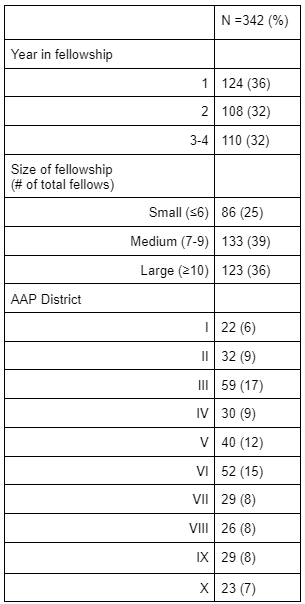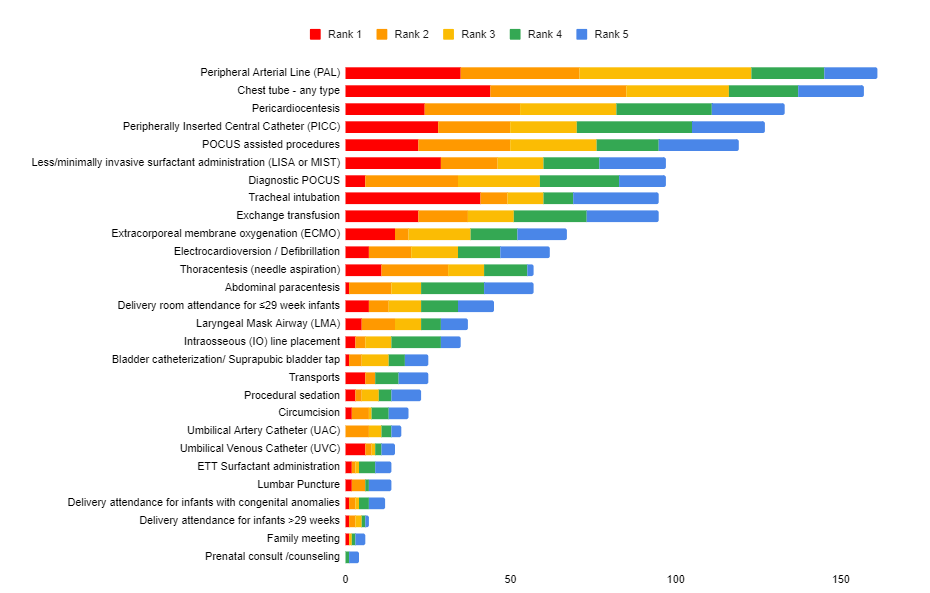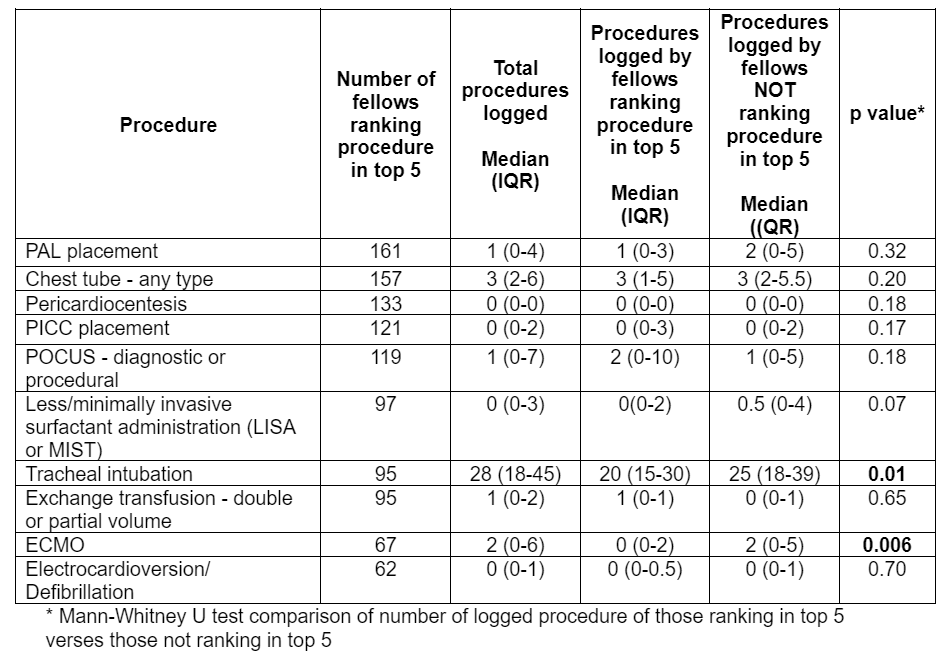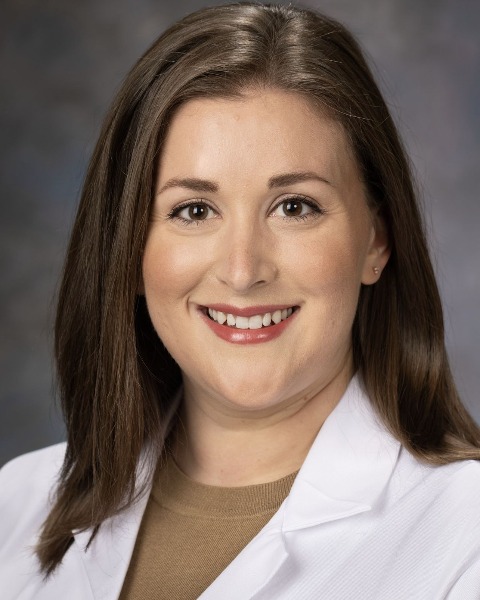Back
Background: NPM fellows have variable procedural experience and exposure based on fellowship program size, patient volume and acuity. Providing NPM fellowship programs with data on national procedural exposure will allow for benchmarking and targeted educational interventions and initiatives to promote procedural competency by fellowship graduation.
Objective: This study aims to describe the influence of prior procedural experience on desired procedural exposure and training for NPM fellows.
Design/Methods: A REDCap survey was distributed to all US NPM fellows in May 2024, and de-identified, self-reported procedure logs and survey responses were collected. From a list of 28 procedures, fellows selected and ranked 5 procedures they desired more experience with. Results were analyzed for the most and least often selected procedures. For a given procedure, the number of logged attempts was compared to its desired experience ranking using Mann-Whitney U testing.
Results: 342 NPM fellows participated in the survey (39% of 875 NPM fellows, Table 1). The procedures ranked most commonly in the top 5 were peripheral arterial line (PAL), chest tube (CT), pericardiocentesis, peripherally inserted central catheter (PICC), and procedural point of care ultrasound (POCUS) (Figure 1). Of the 10 top ranked procedures, only tracheal intubation had a large number of procedural attempts logged (Table 2). Those who ranked tracheal intubation and ECMO exposure as more desired had fewer of those procedures logged compared to those who did not rank them as desired (p < 0.05). There were no differences between the number of logged procedures and procedural ranking for the other 26 procedures.
Conclusion(s): PAL, CT, pericardiocentesis, PICC, and POCUS are identified by fellows for more exposure and training. For most neonatal procedures, there is no association between fellows’ number of prior attempts and their desire for additional exposure. Reviewing fellows’ procedure logs might not accurately predict their procedural training desires and educational needs. Desired procedural exposure, as ranked by NPM fellows, should inform both clinical procedural delegation policies and educational initiatives.
Table 1
 NPM Fellow Participant Demographics
NPM Fellow Participant Demographics
Figure 1
 Procedures Most Frequently Ranked 1-5 by Fellows for Additional Experience
Procedures Most Frequently Ranked 1-5 by Fellows for Additional Experience
Table 2
 Comparison of top 10 procedures logged by fellows who did, and did not, rank the procedure as highly desired for more exposure.
Comparison of top 10 procedures logged by fellows who did, and did not, rank the procedure as highly desired for more exposure.
Table 1
 NPM Fellow Participant Demographics
NPM Fellow Participant Demographics
Figure 1
 Procedures Most Frequently Ranked 1-5 by Fellows for Additional Experience
Procedures Most Frequently Ranked 1-5 by Fellows for Additional Experience
Table 2
 Comparison of top 10 procedures logged by fellows who did, and did not, rank the procedure as highly desired for more exposure.
Comparison of top 10 procedures logged by fellows who did, and did not, rank the procedure as highly desired for more exposure.
Medical Education 5: Procedures and Simulation
Session: Medical Education 5: Procedures and Simulation
232 - Influence of Prior Procedural Experience on Desired Procedural Exposure Among Neonatal-Perinatal Medicine (NPM) Fellows
Saturday, April 26, 2025
2:30pm – 4:45pm HST
Mark R. Castera, Boston University School of Medicine, Boston, MA, United States; Mary T. Crume, University of Texas Southwestern Medical School, Lewisville, TX, United States; Riti Chokshi, University of Texas Southwestern Medical School, Dallas, TX, United States; Shoshana Newman-Lindsay, University of California Davis Children's Hospital, Sacramento, CA, United States; Aashika Janwadkar, John H Stroger Hospital of Cook County, Chicago, IL, United States; Abdul Wasay Khan, Northwestern University The Feinberg School of Medicine, Chicago, IL, United States; Amanda A. Wanous, University of Michigan Medical School, Ann Arbor, MI, United States; Bailey Zeiler, Texas Tech University Health Sciences Center School of Medicine, Lubbock, TX, United States; Megan Gray, University of Washington School of Medicine, Seattle, WA, United States; Heather M. French, Children's Hospital of Philadelphia, Philadelphia, PA, United States

Mary T. Crume, MD (she/her/hers)
Assistant Professor of Pediatrics
University of Texas Southwestern Medical School, Texas, United States
Presenting Author(s)
Background: NPM fellows have variable procedural experience and exposure based on fellowship program size, patient volume and acuity. Providing NPM fellowship programs with data on national procedural exposure will allow for benchmarking and targeted educational interventions and initiatives to promote procedural competency by fellowship graduation.
Objective: This study aims to describe the influence of prior procedural experience on desired procedural exposure and training for NPM fellows.
Design/Methods: A REDCap survey was distributed to all US NPM fellows in May 2024, and de-identified, self-reported procedure logs and survey responses were collected. From a list of 28 procedures, fellows selected and ranked 5 procedures they desired more experience with. Results were analyzed for the most and least often selected procedures. For a given procedure, the number of logged attempts was compared to its desired experience ranking using Mann-Whitney U testing.
Results: 342 NPM fellows participated in the survey (39% of 875 NPM fellows, Table 1). The procedures ranked most commonly in the top 5 were peripheral arterial line (PAL), chest tube (CT), pericardiocentesis, peripherally inserted central catheter (PICC), and procedural point of care ultrasound (POCUS) (Figure 1). Of the 10 top ranked procedures, only tracheal intubation had a large number of procedural attempts logged (Table 2). Those who ranked tracheal intubation and ECMO exposure as more desired had fewer of those procedures logged compared to those who did not rank them as desired (p < 0.05). There were no differences between the number of logged procedures and procedural ranking for the other 26 procedures.
Conclusion(s): PAL, CT, pericardiocentesis, PICC, and POCUS are identified by fellows for more exposure and training. For most neonatal procedures, there is no association between fellows’ number of prior attempts and their desire for additional exposure. Reviewing fellows’ procedure logs might not accurately predict their procedural training desires and educational needs. Desired procedural exposure, as ranked by NPM fellows, should inform both clinical procedural delegation policies and educational initiatives.
Table 1
 NPM Fellow Participant Demographics
NPM Fellow Participant DemographicsFigure 1
 Procedures Most Frequently Ranked 1-5 by Fellows for Additional Experience
Procedures Most Frequently Ranked 1-5 by Fellows for Additional ExperienceTable 2
 Comparison of top 10 procedures logged by fellows who did, and did not, rank the procedure as highly desired for more exposure.
Comparison of top 10 procedures logged by fellows who did, and did not, rank the procedure as highly desired for more exposure.Table 1
 NPM Fellow Participant Demographics
NPM Fellow Participant DemographicsFigure 1
 Procedures Most Frequently Ranked 1-5 by Fellows for Additional Experience
Procedures Most Frequently Ranked 1-5 by Fellows for Additional ExperienceTable 2
 Comparison of top 10 procedures logged by fellows who did, and did not, rank the procedure as highly desired for more exposure.
Comparison of top 10 procedures logged by fellows who did, and did not, rank the procedure as highly desired for more exposure.
